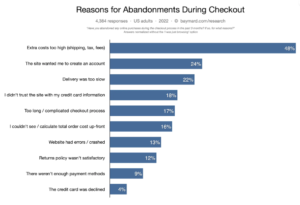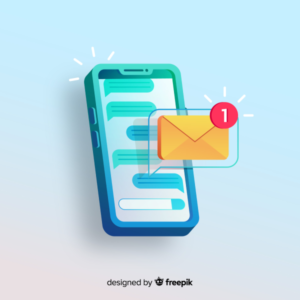Recovering abandoned carts should be a top priority for all eCommerce businesses. These are among the hottest imaginable leads and allowing them to “walk away” is leaving money on the table. Crucially, eCommerce brands need to understand why they moved to checkout and didn’t follow through.
The job is then overcoming any objections they may have had, providing a strong incentive and getting them back in store and completing their purchase.
Put across, our main focus in this article is not optimizing the checkout process, by preventing cart abandonment before it occurs. We’re dealing in the here-and now: a prospect has jumped ship at the possible minute and we need to get them back.
The question is: How do we accomplish that?

Abandoned cart statistics
The Baymard Institute is the authority on digital UX research and according to their work, 69.82% of carts are abandoned. By optimizing the entire checkout process—a combination of UX design and development work—Baymard reckons that over 35% of lost carts could be recovered.
But we’re more interested in abandoned cart recovery than prevention. While the average marketing email enjoys open rates of around 20%, cart abandonment emails have a 39.07% open rate and a 23.33% click-through rate.
But never send just one email. Klaviyo found that sending 3 emails produced 8x the revenue ($24.9m vs $3.8m) compared to single emails. Long story short, the cost of sending a few emails is well worth paying!
Why people abandon their carts
Consumers abandon their carts for a wide variety of reasons. By far, the most dominant is that they were just browsing—they never had any intention to buy. It’s an unusual reason (because why add items to cart?), but it accounts for nearly 60% of cases, according to Baymard.
And there’s nothing we can do about them. But if we discount these cases, we’re left with a beautiful list of addressable causes:
- Unexpected costs (48%)
- Required to create an account (24%)
- Delivery timeframe (22%)
- Lack of trust (for payment) (18%)
- Complicated checkout (17%)
- Hidden total order cost (16%)
- Website errors/poor performance (13%)
- Limited payment methods (9%)
How to overcome these objections
What’s fascinating is that the majority of these can be radically reduced with UX design changes. For example, enable guest checkout then test the results: does the number of conversions and quality of customers change?
Or find some best practices for simplifying the checkout experience. For example, optimizing the number of form fields to reduce friction. Once again, test each variation and see which performs better.

Strategies for abandoned cart recovery
There are a whole host of options to handle abandoned carts. By far the most popular (and, generally, effective) is email retargeting, but we’ll explore the others too. Take a look through these options and see what feels best for your brand and your customers.
Exit-intent popup
Cart abandonment starts the instant a visitor decides to leave the page. So that’s where we strike first!
There are two ways to use exit intent to your advantage in eCommerce.
The first is to try and capture the sale. You offer an incentive (discount or bundle offer) for staying on the page and completing the purchase, or you use persuasion to keep them from leaving.
For example: “Only 5 left in stock. We don’t know when we’ll restock this item”, “Order today for 10% off.”
In both cases, your goal is to create a psychological imperative to stay where you are. You’re recovering the cart before it’s truly abandoned. But there is another tactic.
Exit-intent survey
Thinking bigger picture, you need to know why visitors are abandoning their carts. Use your popup to ask a simple one-question survey: Why have you not bought from us today?
The small percentage of visitors who answer this question are providing invaluable data. You’ll use this to optimize the checkout experience, but it can also inform your retargeting.
For example, if customers felt shipping costs were unexpectedly high, you promote free or discounted shipping when retargeting. By overcoming their biggest objection, you’re more likely to reclaim sales.
Follow-up emails

Emails are a friendly, hands-off way to get your prospect’s attention. As well as solving their likely problem (identified during your one-question survey) you can promote alternative and complementary products, offer bundle deals and other tactics to nudge them back to your store.
These emails typically have high engagement (open and click-through rates) and you can safely send 2-3 emails without risk.
Ad retargeting
Consumers are 40% more likely to engage with tailored ads. Retargeting means showing specific ads to everyone that abandoned your cart, generally on social media. These may feature the product category, some kind of incentive and a CTA to complete the purchase.
The combination of ad retargeting and emails keeps your store top of mind for prospects. The cost of this promotion is small compared to, on average, an impressive return!
Push notifications
This is the territory of “less likely, but possible” solutions. With most eCommerce platforms (like Shopify) you can request permission to send push notifications to the visitor.
The overwhelming majority of visitors will decline. But for those who accept, you can send notifications directly to their browser at any time. Use this to offer your incentive and encourage visitors back to checkout.
Just be warned: if a visitor accepted notifications accidentally, they might respond negatively to notifications. Use push notifications with caution and don’t overdo it. And definitely don’t use trick methods to obtain permission.
SMS reminders
If you’ve captured a lead’s phone number and they’ve consented to marketing, you can text them (or WhatsApp them, if it’s part of your tech stack) using a similar approach to email. SMS enjoys very high open rates, but your messaging must be super concise and actionable—you don’t have much room to work with.
Bonus: Download now a free copy of the ‘Shopping Cart Best Practices for Software and SaaS Sales‘ eBook, for best practices to maximize your conversion rates and revenue!
Add firepower to your recovery strategies
The strategies we shared can all add revenue back into your business. But by augmenting these strategies with the tips below, they’ll perform even better.
- Automating recovery workflows—Everything that follows cart abandonment should be automatic. Using your preferred tool, you should plan out your emails, ads and other communications in advance. You can have alternative flows for different customer types, but never have someone manually serving these emails.
- Monitoring recovery metrics—Are your efforts actually working? Check what percentage of leads are opening your emails, clicking through, and buying. Is your Return On Ad Spend (ROAS) positive? Cart recovery should be profitable, but it’s not guaranteed. Make sure you’re spending your money well and getting the right results.
- Testing and optimization—Ideally you’ll test multiple solutions for cart recovery. For example, run two different ad sets and optimize for clicks. Or two different offers: see which gets used the most (or produces the most profit) and optimize further.
- Including personalized content—Cart recovery is personal. You should be using the lead’s name (if known) and showing the exact products they viewed. You can also show related products (to help with intent) and speak to leads with personality.
- Compelling CTAs and subject lines—Effective copywriting is a necessity. Follow best practices to make your copy as actionable as possible. Try to create intrigue and desire to maximize clicks.
- Survey customers—We talked about the exit-intent survey. But you should also email customers to ask what drove them to buy from you. What were their hesitations? What sold it for them? You can use this data to refine your recovery efforts for better conversions.
Conclusion
Learning how to convert abandoned carts should be a priority for anyone responsible for eCommerce revenue. Remember that most of the legwork is in the setup: your email campaigns, your retargeting ads, your exit-intent popup all happens automatically.
That means you’re recovering carts (and revenue) a long way down the road, on autopilot. The customer understanding you’ll gain from performing this activity can be used to increase conversions all across your marketing, too.
So what are you waiting for? Go find out exactly how many sales you’re losing to cart abandonment and start recovering them today!